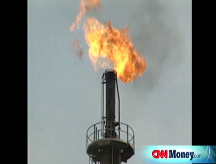Oil falls $2 after Fed announcement
Futures sink after the central bank cuts interest rates; inventory report pressured prices in early trade.

NEW YORK (CNNMoney.com) -- Oil fell sharply Wednesday after the Federal Reserve said it would lower interest rates by 1/4 of a percentage point. Earlier in the day, prices eased following a report that showed supplies of crude increased more than expected last week.
U.S. light crude for June delivery fell $2.17 cents to settle at $113.46 a barrel on the New York Mercantile Exchange. Just before the central bank's announcement, oil was 93 cents lower at $114.70 a barrel.
Prices have fallen $5.29 a barrel since Monday when crude settled at $118.75 a barrel.
In a widely expected move, the Federal Reserve lowered its federal funds rate to 2% and signaled that it may be the last rate cut for the time being. The central bank's statement suggested that it will closely watch inflation pressures and dropped its previous mentions of downside risk to economic growth.
Meanwhile, the Energy Information Administration said crude stocks rose by 3.8 million barrels last week. Analysts were looking for an increase of 1.6 million barrels according to a survey from Platts, an energy research firm.
Crude supplies up more than expected
One of the reasons the supply of crude oil shot up this week is because oil tankers have had trouble delivering their supplies in recent weeks due to fog in the Gulf Coast, according to Phil Flynn, Senior market analyst at Alaron Trading in Chicago.
"Some of this oil that we are seeing was going to be delivered earlier," says Flynn. "The Houston channel was shut down due to bad weather, and so you have all these oil tankers that can't unload cargo and everything grinds to a halt."
Analysts attributed that decline to a monthly energy department report that showed a drop in demand for gasoline in the U.S. and a strengthening in the value of the dollar.
Oil prices increasing on the falling dollar
Oil prices have jumped 15% since the start of the year. Many analysts blame the rise in oil prices on the falling dollar.
"If you take away the support that the weak dollar has given to the price of oil, I think it is going to have a huge effect," said Flynn.
As the dollar continues to depreciate in value, investors have bought oil futures as a hedge against inflation. Also, oil is priced in dollars worldwide, so a falling dollar provides less incentive for oil-exporting countries to increase output, or for foreign consumers to cut back on oil use.
Gas supplies fall more than expected
Gas stockpiles fell by 1.5 million barrels. Analysts were looking for decline of 800,000 barrels. Distillates, used to make heating oil and diesel fuel, rose by 1.1 million barrels. Analysts were looking for an increase in distillate supplies of 150,000 barrels.
Demand for gas remains stunted this week. According to the government report, motor gasoline demand has averaged nearly 9.3 million barrels per day, up by 0.4% from the same period last year. Average demand for gas is usually up 1.5% at this time of year.
One of the reasons that retail gas demand remains so low is that consumers are being pinched at the pump. Retail gas prices have set record highs for 16 days in a row. AAA reports the national average price for a gallon of regular unleaded gasoline rose to a new record of $3.617, up one cent from the previous day's price.
Stunted demand and record high prices has left refineries operating at 85.4% capacity this week, little changed from the week prior. Refineries typically operate around 90% at this time of year. ![]()



